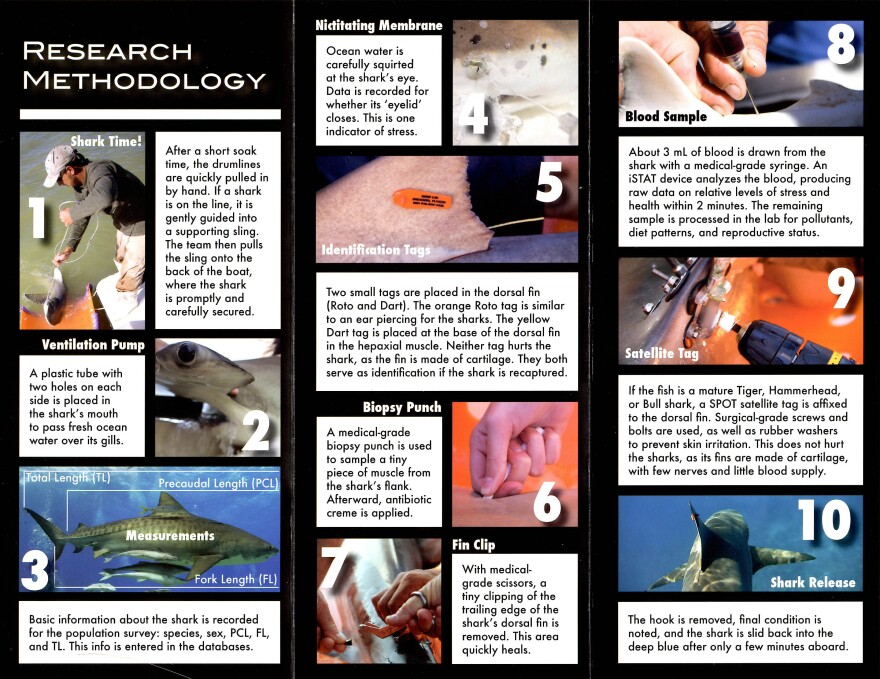On Saturday morning, Neil Hammerschlag stood on the stern of a charter boat frequently used for his innovative shark tagging and research program. The boat had departed just after 9 a.m. from Miami Seaquarium's docks. It stopped just a few miles offshore, Miami's skyline still visible in the distance.
Most of the guests aboard were first-timers. The non-biologists would act as volunteer citizen scientists for the day, assisting Hammerschlag's team of students, staff and interns. They would help in "working up" each shark that was caught with baited drumlines.
Hammerschlag, a research assistant professor and director of the R.J. Dunlap Marine Conservation Program (RJD) at University of Miami, had just wrapped a 26-minute step-by-step tutorial in how and why data is collected from the animals.
RJD intern Dani Escontrela and Hammerschlag used an oversized stuffed shark as a model to demonstrate how the real subjects are caught, guided to a rear platform, secured, ventilated, measured, given ID and satellite tags, fin-clipped, and biopsied. The anticipation was palpable and it was time for expectation management.
"We're all excited. We're all here to hopefully see sharks...but we might not see sharks," Hammerschlag said.
To begin, there are generally fewer sharks in the ocean with each passing day, Hammerschlag said. "Many species" of shark have declined and a recent scientific study estimates that as many as 100 million sharks are killed each year globally, whether intentionally or unintentionally. Many fall victim to the shark fin trade.
Then there's the matter of South Florida's altered coastlines, which are unattractive to sharks and other marine life. Coastal development in this region has cleared out mangroves and seagrass, which serve as shark nurseries, and replaced them with seawalls. These facts served as a reality check to prepare the guests for a potentially shark-free day.
"If we are lucky enough to catch a shark, kind of rejoice in that moment," Hammerschlag said. "I don't know if we're going to see another one. You guys don't know if you'll ever see another one. Savor that moment. Take a good look. If we don't catch anything, realize that's critical data too."
Turns out, there was a lot of rejoicing and hard work ahead. In a six-hour trip with 30 hooks brought in (three "pick ups" each of 10 lines), nine sharks were caught, tested, tagged, and released: three bull sharks, four nurse sharks, and two Atlantic sharpnose. The first catch of the day was a massive female bull, an apex predator and particularly important capture. While all species of shark are tagged and subjected to a few tests, only hammerhead, bull, and tiger sharks are outfitted with a $2,500 satellite tag used by RJD scientists to record shark position, water temperature, and depth.
"Satellite tagging allows us to spy on the secret lives of sharks," Hammerschlag said. "Any day you can deploy one is a good day."
Three satellite tags were deployed on Saturday, one for each bull shark. The RJD website allows users to track tagged sharks' movements on Google Earth. Dedicated marine conservationalists can even "adopt a shark" for a $2,500 tax-deductable donation.
The research expeditions collect data that's used to track shark migration patterns, measure the presence of toxins in muscle tissue, and provide recommendations for sustainable fish-and-release techniques in Florida, among other issues. The boat trips also offer an opportunity for community outreach.
RJD routinely partners with high schools and student groups -- from private schools to alternative schools for juvenile offenders -- to get young people out on the water for hands-on education. Citizen science outings, meanwhile, allow the general public to learn more about marine biology and better understand one of nature's most vilified and misunderstood animals.
Participants can get their feet wet and touch the sharks while helping to conduct tests, or simply spectate. Safety (of humans and sharks) is the top priority and only crew members are permitted to handle the more dangerous aspects of the highly-refined process.
Hammerschlag said that while some of the participants may go on to pursue careers in marine biology or the sciences, his ultimate goal is to instill all guests with a deeper appreciation of the natural world.
"I'd like to create people in all different fields that have a conservation ethic," he said.
To get involved in a trip or learn more about donating to the program, contact RJD.Donate@gmail.com. High school groups or classes can contact RJD.Participate@gmail.com.
Learn more about the step-by-step tagging process below.






